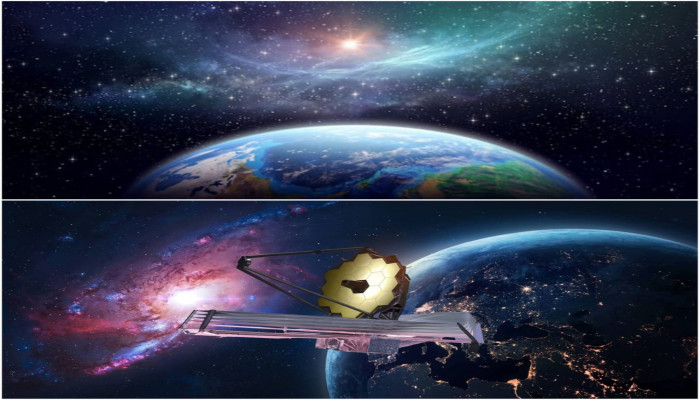Scientists find strongest evidence yet of life on a distant alien planet
- In Reports
- 05:41 PM, Apr 17, 2025
- Myind Staff
In what could be a significant breakthrough, scientists using the James Webb Space Telescope have found the most substantial evidence of possible life outside our solar system. They detected chemical traces in the atmosphere of an alien planet, K2-18 b, that are only produced by living organisms on Earth. The gases found, dimethyl sulfide (DMS) and dimethyl disulfide (DMDS), are created on Earth by microorganisms, mainly marine algae like phytoplankton.
According to researchers, this could mean the planet might be home to microbial life. However, the scientists were careful to clarify that they are not claiming to have discovered actual life, but rather a potential biosignature, an indication of biological activity. They emphasised the need for more data to confirm these findings.
Even so, the team expressed excitement over the discovery. Astrophysicist Nikku Madhusudhan from the University of Cambridge, who led the study, said this marks the first potential sign of life on another planet. The study was published in the Astrophysical Journal Letters. "This is a transformational moment in the search for life beyond the solar system, where we have demonstrated that it is possible to detect biosignatures in potentially habitable planets with current facilities. We have entered the era of observational astrobiology," Madhusudhan stated.
Madhusudhan pointed out that several ongoing efforts are focused on finding signs of life within our solar system, with some suggesting that specific environments, like those on Mars, Venus, or icy moons, could potentially support life. K2-18 b is a planet 8.6 times heavier than Earth and about 2.6 times wider. It orbits within the “habitable zone,” the region around a star where conditions might allow liquid water to exist, an essential factor for life. The planet circles a red dwarf star smaller and dimmer than our sun, located roughly 124 light-years away in the Leo constellation. A light-year is the distance light travels in a year, about 5.9 trillion miles or 9.5 trillion kilometres. Another planet has also been discovered orbiting the same star.
Since the 1990s, scientists have discovered around 5,800 exoplanets, planets outside our solar system. Researchers have proposed the idea of "hycean worlds," which are planets with hydrogen-rich atmospheres and vast oceans of liquid water that might support microbial life. Earlier data from the James Webb Space Telescope, which launched in 2021 and became fully operational in 2022, revealed the presence of methane and carbon dioxide in the atmosphere of the exoplanet K2-18 b. This marked the first time carbon-based molecules were found in a planet's atmosphere within a star’s habitable zone.
"The only scenario that currently explains all the data obtained so far from JWST (James Webb Space Telescope), including the past and present observations, is one where K2-18 b is a hycean world teeming with life," Madhusudhan expressed. "However, we need to be open and continue exploring other scenarios." Madhusudhan explained that if hycean worlds exist, "we are talking about microbial life, possibly like what we see in the Earth's oceans." These planets are thought to have warmer oceans than Earth's. When asked whether more complex life forms or intelligent beings might be possible, he responded, "We won't be able to answer this question at this stage. The baseline assumption is of simple microbial life."
DMS and DMDS, which belong to the same group of chemicals, are considered potential signs of life on exoplanets. The Webb telescope detected one or possibly both of these gases in the planet's atmosphere, with a 99.7% confidence level, leaving a slight 0.3% chance that the result could be due to random variation. These gases were found at concentrations higher than 10 parts per million in the planet’s atmosphere.
"For reference, this is thousands of times higher than their concentrations in the Earth's atmosphere, and cannot be explained without biological activity based on existing knowledge," Madhusudhan expressed.
Experts who weren’t part of the study advised caution when interpreting the findings.
"The rich data from K2-18 b make it a tantalising world," stated Christopher Glein, a principal scientist at the Space Science Division of the Southwest Research Institute in Texas. He added, "These latest data are a valuable contribution to our understanding. Yet, we must be very careful to test the data as thoroughly as possible. I look forward to seeing additional, independent work on the data analysis starting as soon as next week."
K2-18 b belongs to a category of planets known as "sub-Neptunes," which are more significant than Earth but smaller than Neptune, the smallest gas giant in our solar system.
To figure out what an exoplanet’s atmosphere is made of, astronomers use a technique called the transit method. This involves studying the light from the planet’s star as the planet passes in front of it from Earth’s viewpoint. During this transit, the planet causes a slight dip in the star's brightness, and some starlight filters through the planet’s atmosphere. The James Webb Space Telescope can then analyse this filtered light to identify the gases present.
In earlier observations, Webb identified a possible sign of a DMS molecule on K2-18 b. The latest observations used a different tool on the telescope and a new range of light wavelengths to gather more information.
Madhusudhan referred to finding evidence of life on an Earth-like exoplanet as the "Holy Grail" of exoplanet science. He explained that for centuries, humanity has pondered the question, "Are we alone?" and that we could be just a few years away from discovering potential alien life on a hycean world. However, Madhusudhan emphasised the need for caution when making such claims. Madhusudhan explained, "First, we need to repeat the observations two to three times to make sure the signal we are seeing is robust and to increase the detection significance" to a level where the chances of it being a statistical fluke are less than one in a million.
"Second, we need more theoretical and experimental studies to make sure whether or not there is another abiotic mechanism (one not involving biological processes) to make DMS or DMDS in a planetary atmosphere like that of K2-18 b. Even though previous studies have suggested them (as) robust biosignatures even for K2-18 b, we need to remain open and pursue other possibilities," stated Madhusudhan.
Madhusudhan stated that the findings represent "a big if" regarding whether the observations are linked to life, and stressed that "it is in no one's interest to claim prematurely that we have detected life."







Comments